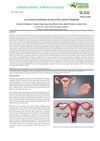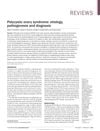TLDR The chapter concludes that diet and lifestyle changes can help manage PCOS symptoms and improve fertility.
The chapter discussed a 31-year-old Asian woman named Nisha, who had a family history of diabetes and faced difficulties conceiving. Her GP noted symptoms such as irregular menstruation, excess hair growth, and acne, leading to a discussion on the clinical diagnostic criteria for Polycystic Ovary Syndrome (PCOS). The chapter explored nutrition and dietetic diagnosis, conditions associated with PCOS, and dietetic interventions. It also considered Nisha's motivation to make dietary changes, dietary restrictions related to Hinduism, her physical activity level, the effects of insulin resistance in PCOS, dietary supplements, and potential barriers to change.
 4809 citations
,
January 2004 in “Fertility and Sterility”
4809 citations
,
January 2004 in “Fertility and Sterility” The 2003 consensus updated PCOS diagnosis criteria and highlighted increased risks of diabetes and heart disease for those affected.
 1 citations
,
June 2019 in “Innovare journal of medical sciences”
1 citations
,
June 2019 in “Innovare journal of medical sciences” Polycystic Ovary Syndrome (PCOS) is a hormonal disorder in women that can cause infertility and other health issues, and it may be improved by treatments that increase insulin sensitivity.
 991 citations
,
January 2011 in “Nature Reviews Endocrinology”
991 citations
,
January 2011 in “Nature Reviews Endocrinology” The document concludes that PCOS is a complex disorder caused by both genetic and environmental factors, affecting women's health in various ways, and requires personalized treatment.
 April 2025 in “International Journal of Multidisciplinary Research in Science, Engineering and Technology.”
April 2025 in “International Journal of Multidisciplinary Research in Science, Engineering and Technology.” Improved care and timely diagnosis are needed for women with PCOD and PCOS, and CystaCare can help.
May 2020 in “International journal of molecular biology” Mutations in the AR gene cause hair thinning and loss.
 88 citations
,
April 2017 in “Journal of Pediatric and Adolescent Gynecology”
88 citations
,
April 2017 in “Journal of Pediatric and Adolescent Gynecology” The document concludes that early diagnosis and treatment of Congenital Adrenal Hyperplasia are crucial for preventing serious health issues and improving patient outcomes.
 7 citations
,
June 2020 in “Journal of Cosmetic Dermatology”
7 citations
,
June 2020 in “Journal of Cosmetic Dermatology” Turkish women with hirsutism experience lower quality of life, especially those with PCOS, regardless of hair growth severity.





